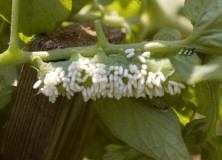Since I’ve been posting a lot about memes recently, and from a POV in opposition to the most prevalent memetic doctrines, I thought I’d post a link to this article (full text is downloadable):
Jeremy Trevelyan Burman. The misunderstanding of memes: Biography of an unscientific object, 1976–1999. Perspectives on Science. Spring 2012, Vol. 20, No. 1, Pages 75-104
Posted Online January 19, 2012.
(doi:10.1162/POSC_a_00057)
© 2012 by The Massachusetts Institute of TechnologyAbstract: When the “meme” was introduced in 1976, it was as a metaphor intended to illuminate an evolutionary argument. By the late-1980s, however, we see from its use in major US newspapers that this original meaning had become obscured. The meme became a virus of the mind. (In the UK, this occurred slightly later.) It is also now clear that this becoming involved complex sustained interactions between scholars, journalists, and the letter-writing public. We must therefore read the “meme” through lenses provided by its popularization. The results are in turn suggestive of the processes of meaning-construction in scholarly communication more generally.
We might, of course, see Burman’s argument as an illustration of how the intentional products of brilliant minds, in this particular case, Dawkins’ original 1976 conception, undergo chaotic if not random, variation and selection in the larger cultural arena. Burman lays the original variation and popularization at the feet of Douglas Hofstadter and Daniel Dennett and their 1981 edited collection, The Mind’s I, which was more popular in its time that Dawkins’ The Selfish Gene.
In The Mind’s I, Hofstadter and Dennett presented a new version of the meme-metaphor. To construct it, they selected harmonious themes from across The Selfsh Gene and presented them as a coherent single work. Although a footnote at the start of the piece indicates that the text had been excerpted from the original, it doesn’t indicate that the essay had been wholly fabricated from those excerpts; reinvented by pulling text haphazardly, hither and thither, so as to assemble a new narrative from multiple sources.
This omission could perhaps be forgiven. The collection was “composed,” after all. But, in the case of the meme, there is more to its composition than a simple departure from the original. The new version provides no clear indication that changes had been made, such as to shift the spelling and punctuation from UK to US standard; or that, in several instances, material had been lifted mid-paragraph and re-presented out of context. Indeed, comments are included from the original—without any editorial remarks—that misrepresent the whole as a coherent unit.
Whoops!
And the rest, as they say, is history. You’ll have to read the full article to get the blow-by-bloody-blow.


And, of course, words never change their definition over time…
That’s a revisionist article, which presents a hatchet job on memes. I don’t recommend getting historical facts from there – many are wrong. Insinuating that the meme died in 1999 is just the tip of an iceberg of incorrect nonsense about memes.
I document the flaws in this article in more detail in one of my own, titled: “Was there a misunderstanding of memes?”